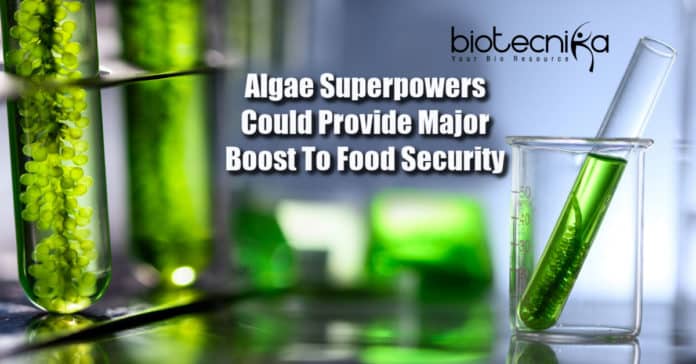Major Boost To Food Security From Algae Superpowers
By providing plants with proteins from algae to boost their growth, the yields of essential food crops like rice, wheat, and soybean could be improved.
The strategy could increase plant yields by approximately 60% and make them extra resilient to climate changes.
This method will help in the initiative to feed the earth’s expanding populace by producing more food from the same amount of land and helping plants survive and flourish even in poor conditions, like drought.
Additionally, the method boosts the photosynthesis mechanism of the plants.
In a study, scientists from the University of Edinburgh, in partnership with the University of Illinois, attempted to improve plant development utilizing a genetic manipulation strategy to boost photosynthesis efficiency.
A vital enzyme in plants associated with photosynthesis, referred to as Rubisco, is inefficient.
Accoring to prior studies, Rubisco typically functions at only half its potential to capture and transform carbon dioxide that helps in plant development.
To overcome this, the researchers used the idea from algae – small single-celled photosynthetic powerhouses present in water bodies where carbon dioxide is rare.
Algae use a specialized carbon dioxide-concentrating mechanism linked to their chloroplasts for enhancing their photosynthesis performance.
A unique liquid-like photosynthetic structure called the pyrenoid has to have been evolved in algae. This structure immerses Rubisco enzymes in the chloroplast with a concentrated amount of carbon dioxide.
The researchers delicately modified the Rubisco enzyme in plants to recreate this pyrenoid-like structure inside plant chloroplasts to function similarly to an algal Rubisco.
Later, a protein referred to as EPYC1 was added to it – an important part of algae’s carbon dioxide-concentrating mechanism and functions as a molecular glue binding multiple Rubisco enzymes together with pyrenoids.
The advancement indicates an important step ahead in enhancing photosynthesis performance, utilizing a technique that is expected to enhance plant development dramatically.
Comparable initiatives to increase photosynthesis in the previous studies have needed substantial modifications to Rubisco, a tough and complicated enzyme to engineering in plants.
Arabidopsis was used in this study as model plants, the outcomes suggest that pyrenoid-like frameworks could be efficiently integrated inside chloroplasts without impeding the plant’s development.
Additionally, the method could yield plants that are more resilient to climate changes. And also minimizes the use of plant fertilizers as it decreases leaf water loss and enables plants to utilize fertilizer a lot more effectively.
The subsequent action will certainly add a carbon dioxide-pumping mechanism to feed the Rubisco-containing pyrenoid with a concentrated supply of carbon dioxide.
The outcomes of the study are issued in Nature Communications. The study was supported by Leverhulme Trust and UK Research and Innovation Biotechnology and Biological Sciences Research Council.
Dr. Alistair J. McCormick, SynthSys & Institute of Molecular Plant Sciences, School of Biological Sciences, University of Edinburgh, said that the pyrenoid is a remarkable liquid-like compartment that assists in making photosynthesis in algae effective. Many interesting breakthroughs on how pyrenoids assemble has come in this year. The capability to develop them in plants can result in considerable increases in carbon dioxide capture and development in plants.
Major Boost To Food Security From Algae Superpowers






